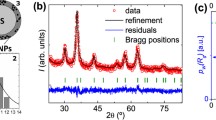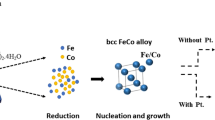Abstract
Magnetite (Fe3O4) and silica-coated magnetite (Fe3O4@SiO2) nanoparticles (NPs) were synthesized and characterized by scanning and transmission electron microscopy and by a.c. susceptibility measurements as a function of the frequency both at room temperature and 80 K. A new mathematical approach based on the explicit coexistence (at room temperature) of Brownian and Néel contributions is proposed: the magnetic data were quantitatively analyzed following this approach and the results well agree with microscopic data. This mathematical procedure allows the achievement of the complete size distribution of coated magnetic NPs in solution as well as the real dimension of the magnetic nuclei.







Similar content being viewed by others
Notes
Thiele G, Poston M, Brown R. A case of study in sizing particles. Micromeritics analytical services. www.particletesting.com
References
Colombo C, Palumbo G, Ceglie A, Angelico R (2012) Characterization of synthetic hematite (α-Fe2O3) Nanoparticles using a multi-technique approach. J Colloid Interface Sci 374:118
Connolly J, St Pierre TG (2001) Proposed biosensors based on time-dependent properties of magnetic fluids. J Magn Magn Mater 225:156
Debye P (1929) Polar molecules. Chemical Catalog Company, New York
Fannin PC, Coffey WT (1995) Contribution of particles inertial effect to resonance in ferrofluid. Phys Rev E 52:6129
Goya GF, Berquó TS, Fonseca FC, Morales MP (2003) Static and dynamic magnetic properties of spherical magnetite nanoparticles. J Appl Phys 94:3520
Griffete N, Clift MJD, Lamouri A, Digigow RG, Mihut AM, Fink A, Rothen-Rutishauser B, Dietsch H (2012) Amino covalent binding approach on iron oxide nanoparticle surface: toward biological applications. Colloids surf A 415:98–104
Im SH, Herricks T, Lee YT, Xia Y (2005) Synthesis and characterization of monodisperse silica colloids loaded with superparamagnetic iron oxide nanoparticles. Chem Phys Lett 401:19
Kerker M (1969) The scattering of light. Academic Press, New York, p 414
Kim J, Piao Y, Lee N, Park YI, Lee I, Lee J, Paik SR, Hyeon T (2010) Magnetic nanocomposite spheres decorated with NiO nanoparticles for a magnetically recyclable protein separation system. Adv Mater 22:57
Koo H, Kano S, Tanaka D, Sakamoto M, Teranishi T, Cho G, Majima Y (2012) Charcaterization of thiolfunctionalized oligo(phenylene-ethynylene)-protected Au nanoparticles by scanning tunneling microscopy and spectroscopy. Appl Phys Lett 101(083115):1–5
Kotitz R, Fannin PC, Trahms L (1995) Time domain study of Brownian and Néel relaxation in ferrofluids. J Magn Magn Mater 149:42
Laurent S, Dutz S, Häfeli UO, Mahmoudi M (2011) Magnetic fluid hyperthermia: focus on superparamagnetic iron oxide nanoparticles. Adv Colloid Interface Sci 166:8
Lu Z, Dai J, Song X, Wang G, Yang W (2008) Facile synthesis of Fe3O4/SiO2 composite nanoparticles from primary silica particles. Colloids Surf A 317:450–456
Lucchini MA, Canepa F (2012) Brownian relaxation of magnetic nanoparticles in fluid: the effect of the solvent. J Nanopart Res 14:809
Ludwig F, Heim E, Schilling M (2009) Characterization of magnetic core–shell nanoparticles by fluxgate magnetorelaxometry, ac susceptibility, transmission electron microscopy and photon correlation spectroscopy-a comparative study. J Magn Magn Mater 321:1644
Mahmoudi M, Sant S, Wang B, Laurent S, Sen T (2010) Superparamagnetic iron oxide nanoparticles (SPIONs): development, surface modification and applications in chemotherapy. Adv Drug Deliv Rev 63:24
Na HB, Song IC, Hyeon T (2009) Inorganic nanoparticles for MRI contrast agents. Adv Mater 21:2133
Nutting J, Antony J, Meyer D, Sharma A, Qiang Y (2006) The effect of particle size distribution on the usage of the ac susceptibility in biosensors. J Appl Phys 99:08B319
O’Handley RC (2000) Modern magnetic materials: principles and applications. Wiley-Interscience, New York
Riani P, Napoletano M, Canepa F (2011) Synthesis, characterization and a.c. magnetic analysis of magnetite nanoparticles. J Nanopart Res 13:7013–7015
Schubert U, Hüsing N (2005) Synthesis of inorganic materials. John Wiley & Son, New York
Shliomis MI, Raikher YL (1980) Experimental investigations of magnetic fluids. IEEE Trans Magn 16:237
Sipos P, Berkesi O, Tombácz E, Pierre TG, Webb J (2003) Formation of spherical iron(III) oxyhydroxide nanoparticles sterically stabilized by chitosan in aqueous solutions. J Inorg Biochem 95:55
Stober W, Fink A, Bohn E (1968) Controlled growth of monodisperse silica spheres in the micron size range. J Colloid Interface Sci 26:62
Veiseh O, Gunn JW, Zhang M (2010) Design and fabrication of magnetic nanoparticles for targeted drug delivery and imaging. Adv Drug Deliv Rev 62:284
Acknowledgments
The support of Miss. Agnese Carino is gratefully acknowledged.
Author information
Authors and Affiliations
Corresponding author
Rights and permissions
About this article
Cite this article
Lucchini, M.A., Riani, P. & Canepa, F. Quantitative analysis of the a.c. susceptibility of core–shell nanoparticles. J Nanopart Res 15, 1601 (2013). https://doi.org/10.1007/s11051-013-1601-x
Received:
Accepted:
Published:
DOI: https://doi.org/10.1007/s11051-013-1601-x




